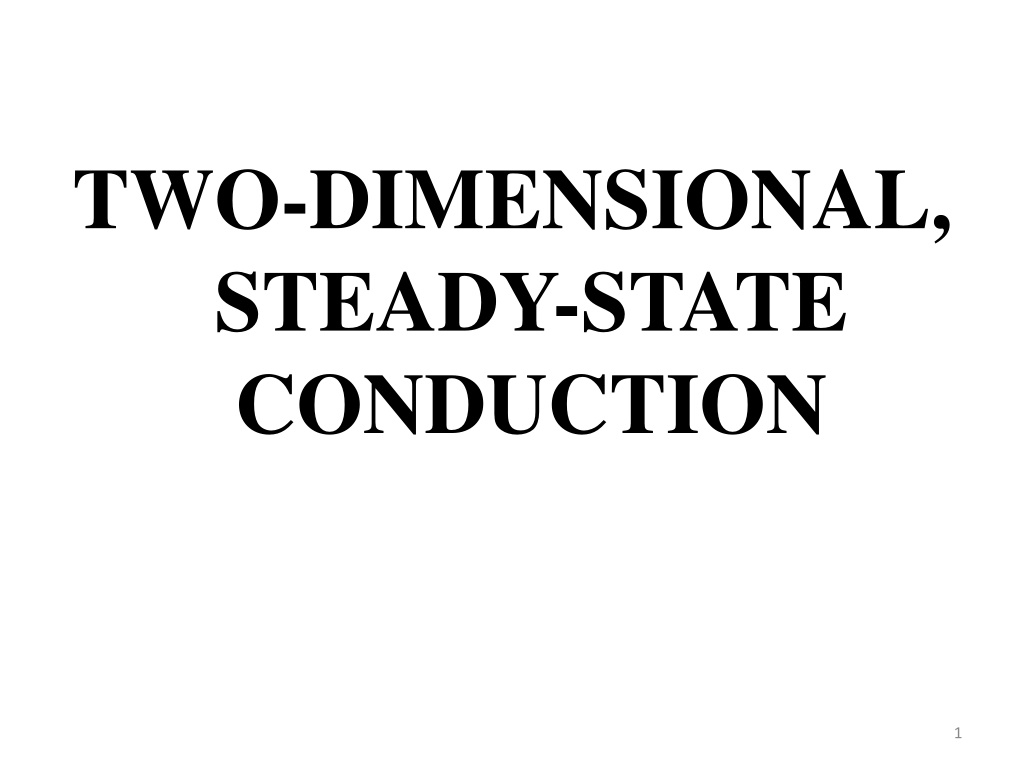
Steady-State Two-Dimensional Conduction Analysis
Explore the methods of solving two-dimensional, steady-state heat conduction problems, including analytical, graphical, and numerical approaches. Learn about the method of separation of variables and boundary conditions for accurate solutions in complex geometries.
Uploaded on | 0 Views
Download Presentation

Please find below an Image/Link to download the presentation.
The content on the website is provided AS IS for your information and personal use only. It may not be sold, licensed, or shared on other websites without obtaining consent from the author. Download presentation by click this link. If you encounter any issues during the download, it is possible that the publisher has removed the file from their server.
E N D
Presentation Transcript
TWO-DIMENSIONAL, STEADY-STATE CONDUCTION 1
In many situations the one-dimensional approach of heat conduction is oversimplification. Multidimensional effects must be accounted for. 4.1 Alternative Approaches Here the two-dimensional, steady state heat conduction will be treated. Again the two major objectives in conduction analysis is determining the temperature field, T(x,y) and then the heat transfer. For two-dimensional steady-state conduction with no generation and constant k, the PDE to be solved is 0 y x 2 2 T 2 T 2 + + = = 2
Methods of solving include analytical, graphical, and numerical (finite difference, finite-element, or boundary element) approaches. The analytical gets the exact solution of the PDE for only a restricted set of simple geometries and boundary conditions. Often the solutions are in series form. The method of separation of variables will be used for this solution. Graphical and numerical solutions give approximate results at discrete points. Graphical solution is restricted to two-dimensional problems involving adiabatic and isothermal boundaries. 3
The method is based on the fact that isotherms must be perpendicular to heat flow lines figchp- 4\fig4.1.pptx. It requires good construction skills. Numerical methods may be used to obtain accurate results for complex, two- or three-dimensional geometries involving a variety of boundary conditions. 4.2 The method of Separation of variables Consider the system shown in figchp-4\fig4.2.pptx. Assumption made is that heat transfer from end surfaces is negligible or ( 2T/ z2) 0 . This will make it a two dimensional problem. 4
To simplify the solution, the following transformation is used T T 1 T T 2 1 Substituting gives 2 2 + + = = 0 2 2 x y For the complete solution of the above PDE two boundary conditions are required for each of the coordinates and these are T(0,y)=T1 and T(x,0)=T1 or (0,y) = 0 and (x,0)=0 T(L,y)=T1 and T(x,W)=T2or (L,y) = 0 and (x,W)=1 5
Because of the transformation, the BCs have been restricted to 0 s and 1. The method of separation of variables assumes a product solution of the form (x,y) = X(x) . Y(y) 2 ' = = = = ' ' X ) x ( ) y ( Y and X ) x ( ) y ( Y 2 x x Similarly 2 = = = = ' ' ' ) x ( X Y ) y ( and ) x ( X Y ) y ( 2 y y Substitution in the PDE of gives 2 2 1 d X 1 d Y + + = = = = ' ' ' ' X Y XY 0 Or 2 2 X dx Y dy 6
Indeed the differential equation is separable. Another observation is that the left hand side expression is only a function of x and the right one only a function of y. The equality can be satisfied only if the expression is independent of x and y. Only a constant can satisfy this condition. Let this constant be 2. This makes the equation 2 2 Y d Y dx X 1 d X 1 = = = = 2 2 2 dy 0 or 2 could have been the constants. But 2 satisfies the prescribed boundary conditions. 7
The resulting differential equations are 2 2 d X 2 d Y 2 + + = = = = 2 2 0 0 dx dy And the solutions are X = C1 cos x + C2 sin x Y = C3 e y + C4 e- y This will give as = XY = (C1 cos x + C2 sin x)(C3 e y + C4 e- y) Using the boundary conditions (1) (0,y) = 0 C1 = 0 (2) (x,0) = 0 (C2 sin x)(C3+ C4) = 0 The only possibility is (C3+ C4) = 0. If C2 = 0 8
It will result in = 0 (not the required solution) This will then give C3 = C4 (3) (L,y) = 0 Gives C2C4 sin L (e y e- y) = 0 As C2 and C4 can not be zeros, the only possibility is sin L = 0 L = n n=0, 1, 2, 3, n=0 makes (x,y) = 0 which is not acceptable. So n=0 will be precluded or n = 1, 2, 3, The solution then becomes ( ( 4 2 e L ) ) n x = = n y / L n y / L C C sin e Combining the two constants, knowing that the new constant may depend on n will give 9
n x n y ) y , x ( = = ( ( e C sin sinh ) ) n L n L Since = 2 sinh (n y/L) As the sum of the solutions is also a solution, then the general solution becomes = = 1 n L n y / L y / L e n x n y ) y , x ( = = C sin sinh n L To obtain Cn, we will apply the last boundary condition (4) (x,W)=1= = =1 n n x n W C sin sinh n L L 10
To determine Cn, some manipulation is required. This requires the knowledge of orthogonality. An infinite set g1(x), g2(x), , gn(x) is said to be orthogonal in the domain if a x b b = = g g ) x ( m ) x ( n dx 0 m n a Most functions exhibit orthogonality including trigonometric functions x n cos and L n x sin for 0 x L L 11
If f(x) is expressed in terms of series of orthogonal functions as = = 1 n = = ) x ( f A g ) x ( n n Then manipulating the above equation as follows a a b b = = n = = g ) x ( f ) x ( dx g ) x ( A g ) x ( dx m m n n 1 And then using the principles of orthogonality, on the right side all the expressions will be zero except one term and the result is given by a b b = = 2 m g ) x ( f ) x ( dx A g ) x ( dx m m a 12
Solving for Am and switching the subscript to n will give = = b 2 n dx ) x ( g ) x ( f b g ) x ( f ) x ( dx n A a n a For our situation gn(x) = sin (n x/L), f(x)=1 and substitution will give x n sin A L 2 L dx + + + + n 1 2 ( ) 1 1 L 0 = = = = n x n n sin dx L 0 13
Substitution in the series representation of f(x) gives = = 1 n L n + ++ + ( ( n ) 1 2 ) 1 1 n x = = 1 sin Recalling the equation of the result of the fourth boundary condition and comparing gives + + + + n 1 2 [( ) 1 ] 1 = = , 3 , 2 , 1 = = C n ... n sinh( n n W / L ) And the resulting final solution will be = = n y sinh + ++ + n 1 2 ( ) 1 1 n x L = = ) y , x ( sin n W n L Isotherms and heat flow lines are shown in figchp- 4\fig4.3.pptx. sinh n 1 L 14
4.3 THE CONDUCTION SHAPE FACTOR AND DIMENSIONLESS CONDUCTION HEAT RATE Conduction shape factors, S are used to report the existing solutions of heat conduction equations. The steady-state heat transfer rate is expressed in dimensionless conduction heat rate, . Heat transfer rate in terms of shape factors may be expressed as q = Sk T1-2 Where T1-2 is the temperature difference between boundaries. * ss q 15
Two dimensional conduction in a square channel of length L. (a) Symmetry planes. (b) Flux plot. (c) Typical curvilinear square. 16
If properly constructed, qi will be the same for all lanes M q M q q = 1 = = i i i M = Number of lanes Application of Fourier s law for the approximate square in a lane T kA q i i T j j ( ) . k y l x x For equal temperature increments across the isotherms N T N T T = = = 1 1 2 j j j 17
If the construction is made with x y then the heat transfer can be estimated by Ml q k T 1 2 N The above equation gives the two dimensional conduction shape factor, S, as S = Ml/N 18
Accordingly the two-dimensional conduction resistance as 1 = 2 ) ( , R t cond D Sk Shape factors have been obtained analytically for numerous two- and three-dimensional systems and the results are summarized in tables.docx. Case 9 is a three dimensional case. For one dimensional cases, shape factors may also be defined for the familiar shapes as follows: Plane wall: A/L Cylinder: Sphere: 4 r1r2/(r2-r1) r 2 L ln / 2 r 1 19
Cases 12 through 15 are for conduction heat rates from isothermal objects at T1 embedded within an infinite medium of uniform temperature (T2) and to facilitate the procedure a characteristic length is defined as Lc (As/4 )1/2 where As is the surface area of the object. Heat transfer rate to the infinite medium is given in terms dimensionless conduction heat rate as )] T T ( kA /[ qL q 2 1 s c ss * Values which have been determined analytically and numerically are given as cases (12)-(15) in 20
Table 4.1. Example 4.1 A metallic electrical wire of diameter d=5mm is to be coated with insulation of thermal conductivity k=0.35 W/m.K. It is expected that, for the typical installation, the coated wire will be exposed to conditions for which the total coefficient associated with convection and radiation is h=15W/m2.K. To minimize the temperature rise of the wire due to ohmic heating, the insulation thickness is specified so that the critical insulation radius is achieved. During the wire coating process, however, the insulation thickness sometimes varies around the periphery of the wire, resulting in eccentricity 21
of the wire relative to the coating. Determine the change in the thermal resistance of the insulation due to an eccentricity that is 50% of the critical insulation thickness. 22 Figure for example 4.1 22
Solution rcr =k/h = 0.35/15= 0.023 m = 23 mm Critical insulation thickness tcr = rcr d/2 = 0.023 0.005/2 = 0.021 m = 21 mm For concentric geometry the thermal resistance is given by . 0 ln[ k 2 ln[ r /( d / 2 )] 023 . 0 /( 005 / 2 )] = = = = 0 . 1 = = ' R m . K / W cr cond , t . 0 ( 2 35 ) For the eccentric wire, use case 7 where z=0.5tcr = 0.5 x 0.021 = 0.010 m 23
+ + 2 2 2 D d 4 z 1 cosh 2 Dd 1 = = = = ' R cond , t Sk 2 k + + 2 2 2 2 ( . 0 x 023 ) . 0 005 4 . 0 x 010 1 cosh 2 ( x 2 . 0 x 023 x ) . 0 005 = = . 0 x 2 35 The reduction in the thermal resistance of the insulation is 0.09 m.K/W or 9%. = 0.91 m.K/W 24
4.4 FIFNITE DIFFERENCE EQUATIONS Large number of two-dimensional problems involve geometries and/or boundary conditions which makes analytical solutions impossible. The best alternative, in such cases is to use numerical technique such as finite difference, finite element or boundary element method. Due to its ease of application, finite difference method will be treated. 4.4.1 The Nodal Network Numerical solution enables determination of temperature at only discrete points. This requires subdividing the medium of interest into a number of small regions with reference points at the centers 25
of the regions as shown in figchp-4\fig4.4.pptx. This reference point is termed as nodal point or node, and the aggregate of points is termed a nodal network, grid, or mesh. m, n represents the node and the temperature at m, n is a measure of the average temperature of the region (shaded area), in this case represented by Tm,n. The temperature distribution shown in (b) is discontinuous. Accuracy of the method depends on how fine the mesh is. 26
4.4.2 Finite Difference Form of the Heat Equation Considering the second derivative ( 2T/ x2) of an interior node, the value of this derivative at the nodal point m, n may be approximated as 2 n , 2 / 1 m x T T / x T / x + + / 1 m n , 2 x 2 @ m n , The above can be determined as T m x + + T T n , 1 + + m n , x m / 1 n , 2 T T T n , 1 m n , m x x 27 / 1 m n , 2
Substitution in the 2nd derivative gives 2 T x + + T 2 T T n , 1 + + n , 1 = = m m ) x m n , 2 2 ( @ m n , Using similar procedures for the y-coordinate will give 2 / 1 n , m y T T / y T / y + + / 1 2 m n , 2 2 y @ m n , + + T T 2 T + + m n , 1 n , ) y m 1 m n , 2 ( 28
Substitution in the differential equation gives + + y x + + T T 2 T 2 2 T 2 T 2 n , 1 + + n , 1 m m ) x T m n , = = 0 2 ( + + T 2 T + + + + m n , 1 m n , ) y 1 m n , 2 ( Using a network for which x = y will give Tm,n+1 + Tm,n-1 + Tm+1,n + Tm-1,n - 4Tm,n = 0 Thus the PDE is reduced to an algebraic equation which gives the temperature at a node as the average of the temperatures of the four neighboring nodes. 29
4.4.3 The Energy Balance Method This is an alternative method to develop the finite difference equations for nodes. The approach is more versatile than the one seen before. It uses energy conservation principle and assumes that all heat transfer is into the node as shown in figchp- 4\fig4.5.pptx.The analysis will consider heat generation too. For a unit depth q 0 E E 1 i = = 4 + + = = + + 1 ( y = = ' ' ' q [ x )] 0 ) i ( in g m n , 30
The conduction heat rate from each node can be written as T T n , 1 = = ) 1 . y m m n , q k ( n , 1 ( m ) ( m n , ) x T T n , 1 + + = = ) 1 . y m m n , q k ( n , 1 + + ( m ) ( m n , ) x T T + + = = ) 1 . x m n , 1 m n , q k ( ) 1 + + ( m n , ( m n , ) y T T = = ) 1 . x m n , 1 m n , q k ( ) 1 ( m n , ( m n , ) y 31
Using x =y and substituting in the summation equation will give Tm,n+1 + Tm,n-1 + Tm+1,n + Tm-1,n - 4Tm,n = 0 With no heat generation it gives the same equation. Equations must also be developed for nodes lying on the boundary surface of the object. The surface may enjoy convection heat transfer as shown in figchp- 4\fig4.6.pptx which is an internal corner. The equations can be developed as ) x 2 ( q + + k 32
T T n , 1 = = ) 1 . y m m n , q k ( n , 1 ( m ) ( m n , ) x T T 1 n , 1 + + = = ) 1 . y m m n , q k ( n , 1 + + ( m ) ( m n , ) 2 x T T + + = = ) 1 . x m n , 1 m n , q k ( ) 1 + + ( m n , ( m n , ) y T T 1 = = ) 1 . x m n , 1 m n , q k ( ) 1 ( m n , ( m n , ) 2 y Convection: q m ( ) ( x y = = + + h 1 . ( T T ) h 1 . ( T T ) n , ) m n , m n , 2 2 33
With no energy generation and steady-state and network with x = y = = E 0 in 1 h x h x + + + + + + + + + + = = T T ( T T ) T 3 T 0 n , 1 + + n , 1 + + m m n , 1 m m n , 1 m n , 2 k k Nodal energy balance equations for several common geometries is given in Table 4.2. Example 4.2 Using the energy balance method, derive the finite difference equation for the m, n nodal point located on a plane, insulated surface of a medium with 34
Solution Using the energy conservation for node m,n x + + + + + + + + 1 . y = = ' ' ' q q q q q . 0 1 2 3 4 2 where T T n , 1 = = ) 1 . y m m n , q ( k 1 x T T x = = m n , 1 m n , q ( k ) 1 . 2 2 y = = q 0 3 T T x + + = = m n , 1 m n , q ( k ) 1 . 4 2 y 36
Substituting in the energy balance equation and simplifying gives . x ) y ' ' ' q ( + + + + + + + + = = 2 T T T 4 T 0 n , 1 + + m m n , 1 m n , 1 m n , k 37
The finite difference equations may also be formulated using the thermal resistance concept. For the example of the corner node (internal) = R cond t y T T T T , 1 , , 1 /( T , = m n m n m n m n q , 1 ( ) ( , ) m n m n . 1 . T ) x k , T T R , , = = m n m n q ( ) ( , ) m n 1 x y , t cond + 1 . 1 . h 2 2 The utility of the resistance can come when considering two nodes of dissimilar materials with a contact resistance between them figchp- 4\fig4.7.pptx. n , m ) 1 n , m ( ) n , m ( R T T = = m n , 1 q 38 tot
Where ' ' c , t R y / 2 y / 2 = = + + + + R tot ) 1 . x 1 . x ) 1 . x k ( k ( A B 4.5 SOLVING THE FINITE DIFFERENCE EQUATIONS These equations are the result of the nodal equations. For N-nodal points there will be N equations. The result is N linear algebraic with N unknown temperatures. Two types of solutions will be dealt with Direct and iterative 39
For small equations, direct is suitable while for larger ones, iterative is better. 4.5.1 The Matrix Inversion Method This is a direct solution. The nodal equations are ... T a T a T a + + + + + + + + + + + + + + + + = = a T C 11 1 12 2 13 3 1 N N 1 = = a T a T a T ... a T C 21 1 22 2 23 3 2 N N 2 . . . . . . . . . . . . . . . + + + + + + + + = = a T a T a T ... a T C N 1 1 N 2 2 N 3 3 NN N N 40
Using matrix notation, the above can be written as [A][T] = [C] where N 2 22 21 . . . A a a ... a T C 11 12 1 N 1 1 a a ... a T C 2 2 , . . . . , T , C . . . . . . . . T C a a ... a N N N 1 N 2 NN 41
Since [A]-1[A] = I , then [A]-1[A][T]= [A]-1[C] or [T] = [A]-1[C] If the inverse of A is defined as b b ... b 11 12 1 N b b ... b 21 22 2 N . . . A 1 . . . . . . b b ... b N 1 N 2 NN 42
The solution then becomes T1 = b11C1 + b12C2+ + b1NCN T1 = b11C1 + b12C2+ + b1NCN . . . . . . . . . . . . T1 = b11C1 + b12C2+ + b1NCN Matrix inversion can easily be done by calculators and computers. For large equation, this procedure is time consuming. 43
4.5.2 Gauss-Seidel Iteration This is an iteration procedure and is good for large equations. The following procedure is followed. 1. As much as possible, the equations should be reordered to have the largest coefficient at the diagonal for quick convergence. 2. After reordering, each of the N equations should be written in explicit form as a a = = a i 1 N C ij ij = = ( k ) ( j k ) ( j k ) 1 T T T i i a a j = = i + + j 1 1 ii ii ii 44
where i = 1, 2, .., N. The superscript k refers to the level of iteration. 3. An initial (k=0) value is assumed for each temperature Ti. 4. Setting k=1 in the equation, values of Ti(1) are then calculated by substituting assumed values in the second summation or new values in the first summation. This step is the first (k=1) iteration. New values of Ti(k)are determined from Tj(k) values of the current iteration, where 1 j i-1, and the Tj(k-1) values of the previous iteration, where i+1 j N 45
5. The iteration is terminated when a prescribed criterion is satisfied. ) 1 k ( k ) ( T T i i Example 4.3 A large industrial furnace is supported on a long column fire clay brick, which is 1m by 1m on a side. During steady-state operation, installation is such that three surfaces of the column are maintained at 500 K while the remaining surface is exposed to an airstream for which T = 300 K and h = 10 W/m2.K. Using a grid of x = y = 0.25 m, determine the two dimensional where represents an error margin. 46
temperature distribution in the column and the heat rate to the airstream per unit length of column. 47
Solution There are 12 nodes. By symmetry the unknowns will be reduced to 8. For interior nodes 1, 2, 3, 4, 5, and 6, the finite difference equations are Node 1: T2 +T3 + 1000 - 4T1 = 0 Node 2: 2T1 +T4 + 500 - 4T2 = 0 Node 3: T1 +T4 + T5+ 500 - 4T3 = 0 Node 4: T2 +2T3 + T6 4T4 = 0 Node 5: T3 +T6 +T7 + 500 - 4T5 = 0 Node 6: T4 +2T5 + T8 - 4T6 = 0 48
For the surface nodes 7 and 8, use equation 4.42 using h x/k=2.5 Node 7: 2T5 + T8 + 2000 - 9T7 = 0 Node 8: 2T6 + 2T7 + 1500 - 9T8 = 0 49
-4T1 + T2 + T3 + 0 + 0 + 0 + 0 + 0 = -1000 2T1- 4T2 + 0 + T4 + 0 + 0 + 0 + 0 = -500 T1 + 0 - 4T3 + T4 + T5 + 0 + 0 + 0 = -500 0 + T2 +2T3- 4T4+ 0 + T6+ 0 + 0 = 0 0 + 0 + T3 + 0 -4T5 +T6 +T7 + 0 = -500 0 + 0 + 0 + T4 +2T5-4T6 + 0 + T8 = 0 0 + 0 + 0 + 0 +2T5+ 0 -9T7+ T8 = -2000 0 + 0 + 0 + 0 + 0 +2T6+2T7-9T8= -1500 50













